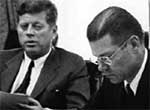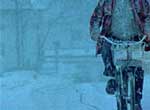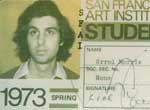by Terrence Rafferty
The New Yorker - September 5, 1988
Errol Morris's documentaries have a luxuriant weirdness, a deep
unfamiliarity. In his first two films -- "Gates of
Heaven"(1978), a report on pet cemeteries in California,
and "Vernon, Florida" (1981), a loosely assembled
collection of tales from a small Southern town, told by rambling
coots and half-demented good old boys -- his choice of material
and his fondness for lingering on the cracked discourse of his
interview subjects identified him as a true connoisseur of
native eccentricity, a hoarder of oddball Americana. His new
movie, "The Thin Blue Line," shows that he's more than
an inspired believe-it-or-not artist. Telling the story of a
1976 cop-killing in Dallas, and detailing the process by which a
man who is almost certainly innocent was convicted and sentenced
to death for the crime (with the likely killer as the
prosecution's star witness), Morris burrows into a nightmarish
realm of duplicity, faulty perception, and bottomless ambiguity.
The movie is both detached and fanatically intense. Its
materials have the heterogeneity, the heedless
comprehensiveness, of documents in a dossier: there are
interviews with the principals, close ups of key words and
paragraphs from the newspaper accounts, courtroom sketches,
maps, family-album snapshots of the suspects, diagrams of the
crime scenes and of the entry and exit wounds in the victim's
body, and a series of eerie reenactments of witnesses' different
versions of the murder and the events that led up to it. But
this stuff isn't organized in ways that we're used to. "The
Thin Blue Line" doesn't have the structure either of
"60 Minutes" style investigative journalism or of
detective fiction, though it borrows elements from both; its
form is circular, spiraling, its obsessive, repetitive visual
motifs echoed in Philip Glass's hauntingly monotonous score.
This is documentary as epistemological thriller; Morris seems to
want to bring us to the point at which our apprehension of the
real world reaches the pitch of paranoia -- to induce in us the
state of mind of a detective whose scrutiny of the evidence,
whose search for the connections between stubbornly isolated
facts, has begun to take a feverish clarity of
hallucination.
The movie is a trance-like, almost lyrical rendering of a small,
messy murder case -- the kind of story that's usually found in
local newspapers and, sensationalized, in true-detective
magazines -- and it's as hypnotic as "Vertigo."
Although Morris himself does appear in "The Thin Blue
Line," he is this film's true detective, the investigator
whose insomniac consciousness keeps reshuffling the evidence,
generating ambiguous images of the crime from the contradictory
testimony of witnesses, swerving constantly between words and
pictures, between facts and hypotheses. He came upon the story
by accident. In 1985, Morris was interviewing prisoners in a
Texas penitentiary for a documentary on James P. Grigson, a
Dallas psychiatrist who is known as Dr. Death, because his
expert testimony in capital cases virtually guarantees that the
defendant will be sentenced to death. One of the filmmaker's
interview subjects was a man named Randall Adams, who claimed to
have been wrongly convicted of a policeman's murder. Morris did
some digging into the records of the case and trial, became
convinced that Adams was innocent, and wound up on a long detour
from the Dr. Death movie; the question of how Randall Adams
could have landed in jail for something he probably didn't do
took over the filmmaker's mind. Undoubtedly, the urgent,
compulsive quality of "The Thin Blue Line" is, at
least in part, a consequence of the film's unusual origin. The
subject seems to have seized Morris's imagination unexpectedly
-- in much the same way another Dallas murder, the Kennedy
assassination, has drawn people, almost against their will, into
its labyrinth of half-truths and contradictions, closed files
and intimations of conspiracy.
Officer Robert Wood was killed on a cold night in November,
1976. He and his partner had stopped a car in a bad section of
town just to tell the driver to turn his headlights on; when
Wood reached the window on the driver's side, he was shot,
several times, by the man at the wheel. Since the crime was
apparently so senseless, and since the only known witness,
Wood's partner, wasn't very observant (the movie suggests that
she may have violated proce-dure by remaining seated in the
patrol car, drinking a milkshake, while Wood approached the
killer's car), the Dallas police had no leads and hardly any
clues. A month later, they questioned sixteen-year-old David
Harris, who had been bragging to his buddies in the small town
of Vidor that he had killed a Dallas cop. He admitted to the
police that he had been in the car that Wood pulled over, but
claimed that the person who had done the shooting was Randall
Adams, a hitchhiker he had picked up earlier that day. After
interrogating Adams -- who insisted that the teenager had
dropped him off at his motel a couple of hours before the time
of the murder, and who refused to sign a confession -- the
police decided that they would believe Harris, despite what
might have seemed fairly strong circumstantial evidence pointing
to him as the killer: both the murder weapon and the car had
been stolen by Harris in Vidor; since he knew that the car was
stolen, he would have had far more reason than Adams to panic at
being stopped by a patrol car; he had a substantial criminal
record, and was facing charges in Vidor at the time he gave his
evidence, whereas Adams had no record at all and no history of
violence. So why, the movie asks, was Adams prosecuted, much
less convicted and sentenced to death?
Morris's answers, or suggestions of answers, are complex, and
whirl by us at such speed that we're barely able to keep up. We
register one fact, and then another comes at us, then another
and another, until, finally, we seem to be taking it all in on
an almost subliminal level -- our attention is so intensely
focused that everything resonates, ev-erything connects, with a
logic we have stopped even trying to articulate. In showing us
the lies, the fears, the social pressures, the cultural
influences, the unwarranted assumptions, the ulterior motives,
the stubbornness, and the plain confusion that combined to
produce the case against Randall Adams, Morris -- who has a
degree in philosophy, and who once worked as a private detective
-- seems to be investigating not just this squalid murder but
the very nature of untruth. It's hard to think of another movie
(let alone another documentary) that has such a richly developed
sense of the texture of falsehood, that picks out so many of the
strands that, woven together, blind us. The Dallas police, their
anger stirred and their pride challenged by the murder of one of
their own, needed to arrest someone; if they believed Harris,
they had a crime with a witness; if they believed Adams, then
Harris was alone in the car, and they had nothing. The District
Attorney, Douglas Mulder, who had never lost a capital case,
needed a conviction and a death sentence: Harris, as a juvenile,
couldn't be tried for first-degree murder; Adams, who was
twenty-seven, could. At the trial, the victim's partner, who was
feeling the heat of a departmental investigation of her conduct
on the night of the killing and therefore may have been
especially eager to cooperate, changed her testimony from her
original report: having initially said that there was only one
person in the car, she now claimed to have seen two; the driver
was now described as having had bushy shoulder-length hair (like
Adams), rather than short hair and a fur-collared jacket (like
Harris). The judge, the son of an F.B.I. agent, was a man with a
passion for law enforcement; he admits that he "welled
up" during the D.A.'s emotional closing argument about
"the thin blue line" of police risking their lives to
protect society. One of the prosecution's chief witnesses,
sprung on the defense at the last moment, was a woman named
Emily Miller, who "used to watch all the detective shows on
TV" and loved to make herself useful to the authorities --
particularly in this case, since there was a
twenty-one-thousand-dollar reward involved, and her daughter had
just been arrested for a felony. (The charges were quietly
dropped.)
Morris sucks us into the process by which a man, Randall Adams,
becomes a kind of fictional character in a story whose momentum
seems unstoppable. Adams, labeled a "drifter" by the
police and the press (although he had been holding down a decent
job ever since he arrived in Dallas, two months before the
murder), is, when we see him interviewed in prison, a wan,
ghostly, soft-spoken man. He's much thinner than the mustached
hippie we've seen in newspaper photos from the time of his
arrest, and he has a flat, weary voice. Although Adams isn't on
Death Row anymore -- in a complicated legal maneuver, the
State of Texas commuted his sentence to life imprisonment in
1977 (after the Supreme Court struck down his death penalty), so
that it wouldn't have to give him a new trial -- he looks and
sounds like someone on the verge of disappearing. He seems
barely real, a shadowy image animated only sporadically by
glints of bitter humor. The re-creations of the murder and the
events surrounding it have a stronger presence than Adams
himself. Even when these scenes are representing accounts that
are probably false, they're compelling. We watch the same
actions occur over and over again, with slight but significant
variations, on the same dark stretch of road -- a setting that
Morris endows with an unearthly vividness, composed of the
piercing beams of headlights, silhouetted figures, flashes of
gunfire, the revolving red light on top of the police car, and
rich, enveloping nighttime blackness -- and we think, against
all reason, that one more detail, a different angle of vision,
will suddenly reveal the truth, that these reconstructions
somehow have the power to take us to the heart of things. Once
David Harris had told his story, Randall Adams' life was
obliterated, to be replaced by an endless series of
constructions and reconstructions of a single moment (a moment
at which he was most likely asleep in his motel room). It's as
if time had simply stopped for him the instant the image of him
shooting Robert Wood lodged in the minds of the Dallas police,
and he had been condemned to live the rest of his life
exclusively in the minds of others: cops, judges, juries,
lawyers, newspaper readers, Errol Morris, audiences watching
this movie -- all of us, for our various reasons, rehearsing
that terrible moment, with the figure of Randall Adams
flickering in and out of the picture.
Adams' fate is worthy of a Borges hero, one of those melancholy
spirits trapped in infinite loops of metaphysical treachery.
It's no small feat for Morris to have made a documentary that
evokes this kind of existential unease in its audience. There
are times, though, when things get all muddy and confused, and
that's not because reality is, you know, hopelessly ambiguous;
it's because the filmmaker's style is too fancy and elliptical,
or because he just hasn't bothered to give us information we
need. The legal proceedings, in particular, are almost never
entirely lucid. The flowering absurdity of Adams' experiences
with the courts wouldn't lose its horror if Morris troubled to
explain a few crucial points of law. But this is a powerful and
thrillingly strange movie, and Morris's occasional excess of
artiness shouldn't be taken as an indication of indifference to
the reality of Randall Adams' plight. In fact, the filmmaker
himself uncovered several pieces of new evidence, testified in
Adams' behalf at hearings on motions for retrial, and coaxed a
near-confession out of David Harris, which we hear, on tape, in
the movie's final scene. (Harris has since, in a recent
interview with a newspaper reporter, come even closer to an
outright admission of guilt. He's on Death Row for another
murder, and Adams is still petitioning for a new trial.) Morris,
who clearly has a very sophisticated understanding of the
relationship between art and reality, did a thorough,
painstaking investigation in the real world, and then did
something different on film: he turned the case into a kind of
tabloid poetry, a meditation on uncertainty and the fascination
of violence. If we quibble every now and then with his
presentation of the facts, it's his own fault; "The Thin
Blue Line" makes us all obsessed detectives.
True Detective
REVIEWS/ARTICLES
Todd McCarthy (Fog of War)
Fred Kaplan (Fog of War)
Samantha Power (Fog of War)
Ron Rosenbaum (Fog of War)
Kenneth Turan (Fog of War)
Peter Applebome (Mr. Death)
Ron Rosenbaum (Mr. Death)
Todd McCarthy (Fast, Cheap & Out of Control)
David Ansen (Fast, Cheap & Out of Control)
Roger Ebert (The Thin Blue Line)
Janet Maslin (Vernon, Florida)
Alan Berger (Gates of Heaven)
Michael Covino (Gates of Heaven)
Roger Ebert (Gates of Heaven)
MORE TBL
Synopsis
Harvey Weinstein Letter
Watch Clip
Transcript
Storyboards
Five Key Witnesses
Adams Mugshot
Harris Mugshot
Interview Gallery
The Anti-Post-Modern Post-Modernist (Lecture)
BUY THIS MOVIE
Criterion Collection
OTHER FILMS
Gates of Heaven
Vernon, Florida
A Brief History of Time
Fast, Cheap & Out of Control
Mr. Death
The Fog of War
Standard Operating Procedure
Tabloid
The Unknown Known
The B-Side
Wormwood American Dharma







